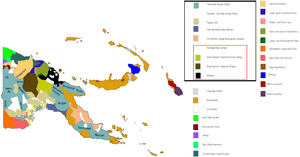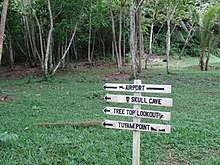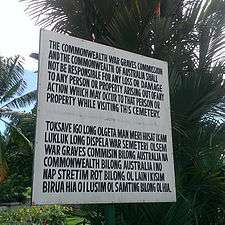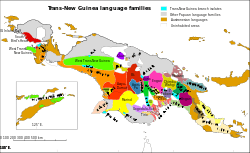Languages of Papua New Guinea
There are 851 languages spoken in Papua New Guinea. In 2006, Papua New Guinea Prime Minister Sir Michael Somare stated that "Papua New Guinea has 832 living languages (languages, not dialects),"[1] making it the most linguistically diverse place on Earth.[2][3] Languages with statutory recognition are Tok Pisin, English, Hiri Motu, and Papua New Guinean Sign Language.[4] Tok Pisin, an English-based creole, is the most widely spoken, serving as the country's lingua franca. Papua New Guinean Sign Language became the fourth officially recognised language in May 2015, and is used by the deaf population throughout the country.
| Languages of Papua New Guinea | |
|---|---|
 | |
| Official | Tok Pisin, English, Hiri Motu, Papua New Guinean Sign Language |
| Lingua franca | Tok Pisin |
Languages
English

English is an official language of Papua New Guinea and is used by the government, courts, and the education system. In the 2011 census, 48.9% of the population were literate in English.[5]
German
From 1884 to 1914, the northern half of the present-day country was a German colony known as German New Guinea, in which German was the official language. Tok Pisin derives some vocabulary from German as a result of this influence. German is not now a generally spoken language in Papua New Guinea.
Unserdeutsch
Unserdeutsch, or Rabaul Creole German, is a German-based creole language spoken mainly in East New Britain Province. It is the only creole language that has developed from colonial German. The lexicon is derived from German, while the substrate language is Tok Pisin.[6]
Tok Pisin

Tok Pisin is an English-based creole language spoken throughout Papua New Guinea. It is an official language of Papua New Guinea and the most widely used language in the country. In parts of Western, Gulf, Central, Oro and Milne Bay provinces, however, the use of Tok Pisin has a shorter history, and is less universal especially among older people. In the 2011 census, 57.4% of the population were literate in Tok Pisin.[5]
Hiri Motu
Hiri Motu, also known as Police Motu, Pidgin Motu, or just Hiri, is a simplified version of the Motu language of the Austronesian language family. In the 2011 census, 4.7% of the population were literate in Hiri Motu.[5]
Papuan languages

.jpg)
Outside Papua New Guinea, Papuan languages that are also spoken include the languages of Indonesia, East Timor, and the Solomon Islands.
Below is a full list of Papuan language families spoken in Papua New Guinea, following Palmer, et al. (2018):[7]
- Trans-New Guinea
- Madang
- Finisterre-Huon
- Kainantu-Goroka
- Chimbu-Wahgi
- Enga-Kewa-Huli
- Bosavi
- East Strickland
- Kutubu
- Duna-Bogaya
- Wiru
- Ok-Oksapmin (also in Indonesia)
- Anim (also in Indonesia)
- Gogodala-Suki
- Turama-Kikori
- Kiwaian
- Awin-Pa
- Angan
- Greater Binanderean
- Dagan
- Mailuan
- Koiarian
- Goilalan
- Yareban
- Kwalean
- Manubaran
- Torricelli
- Sepik
- Lower Sepik-Ramu
- Border (also in Indonesia)
- Sko (also in Indonesia)
- Eastern Pauwasi (also in Indonesia)
- Senagi (Angor-Dera) (also in Indonesia)
- Kwomtari
- Leonhard Schultze (Walio-Papi)
- Upper Yuat (Arafundi-Piawi)
- Yuat
- Left May
- Amto-Musan
- Busa
- Taiap
- Yadë
- Yam (also in Indonesia)
- Pahoturi River
- Eleman
- Oriomo
- Teberan
- Doso-Turumsa
- Dibiyaso
- Kaki Ae
- Kamula
- Karami
- Pawaia
- Porome
- Purari
- Tabo
- Baining
- North Bougainville
- South Bougainville
- Butam-Taulil
- Anêm
- Ata
- Kol
- Kuot
- Makolkol
- Sulka
- Yélî Dnye
Austronesian languages
People speaking languages belonging to the Austronesian family arrived in New Guinea approximately 3,500 years ago.
Austronesian languages spoken in Papua New Guinea include Meso-Melanesian languages (such as Nalik, spoken in New Ireland Province; Kuanua, spoken in East New Britain Province; and Nakanai spoken in West New Britain Province).
The Austronesian languages are widely spread across the globe, as far west as Malagasy in Madagascar, as far east as Rapa Nui in Easter Island, and as far as north as the Formosan languages of Taiwan. Austronesian has several primary branches, all but one of which are found exclusively on Taiwan.
Literacy
In 2011, 67.6% of the population of Papua New Guinea over 10 years of age were literate.[5]
Notes
- (Statement at the World Leaders Forum Archived 2008-03-18 at the Wayback Machine, Columbia University, September 21, 2006; website of the Prime Minister of Papua New Guinea).
- "Seven decades after Independence, many small languages in India face extinction threat".
- A.V. (24 July 2017). "Papua New Guinea's incredible linguistic diversity". The Economist. Retrieved 20 July 2017.
- There is no specific legislation proclaiming official languages in Papua New Guinea. In the constitution of Papua New Guinea, section 2(11) (literacy) of its preamble mentions '...all persons and governmental bodies to endeavour to achieve universal literacy in Pisin, Hiri Motu or English' as well as "tok ples" and "ita eda tano gado". In addition, section 67 (2)(c) mentions "speak and understand Pisin or Hiri Motu, or a vernacular of the country, sufficiently for normal conversational purposes" as a requirement for citizenship by nationalisation; this is again mentioned in section 68(2)(h).
- "2011 Census National Report" (PDF). Papua New Guinea National Statistical Office. p. 57. Retrieved 3 May 2020.
- Maitz, Volker, Peter, Craig Volker (2017). "Documenting Unserdeutsch Reversing Colonial Amneasia" (PDF). Journal of Pidgin and Creole Languages: 365–397.
- Palmer, Bill (2018). "Language families of the New Guinea Area". In Palmer, Bill (ed.). The Languages and Linguistics of the New Guinea Area: A Comprehensive Guide. The World of Linguistics. 4. Berlin: De Gruyter Mouton. pp. 1–20. ISBN 978-3-11-028642-7.
References
- Gordon, Raymond G., Jr. (ed.) (2005). Ethnologue: Languages of the World (Fifteenth ed.). Dallas, Tex.: SIL International.CS1 maint: multiple names: authors list (link) CS1 maint: extra text: authors list (link)
External links
- Language distribution maps for individual PNG provinces (SIL International in Papua New Guinea)
Countries.png)